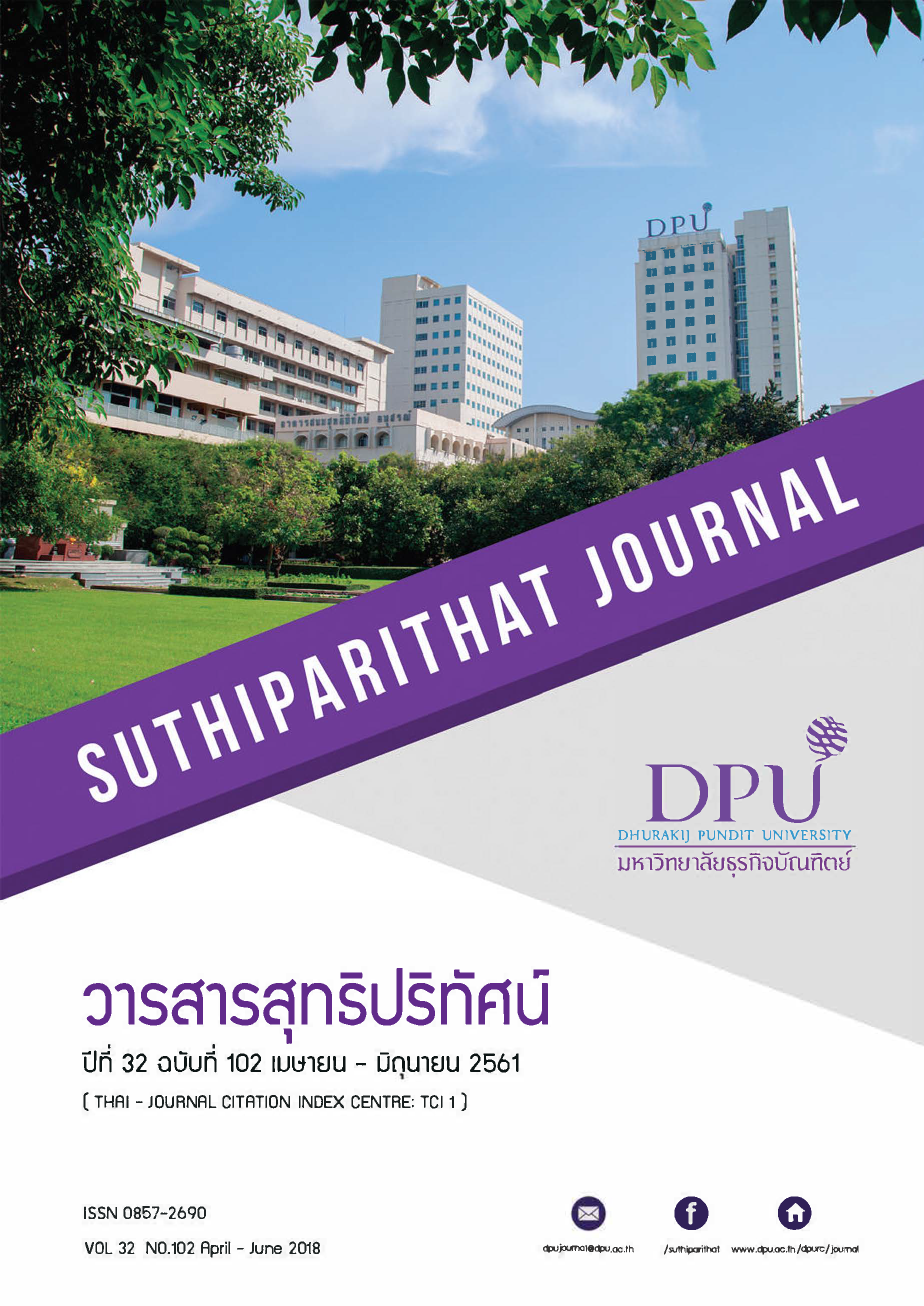พฤติกรรมการซื้อและปัจจัยส่วนประสมทางการตลาดของผลิตภัณฑ์เครื่องทำความเย็นที่เป็นมิตรต่อสิ่งแวดล้อม: การศึกษาเปรียบเทียบระหว่างผู้บริโภคไทยและเยอรมนี
คำสำคัญ:
พฤติกรรมการซื้อ, ส่วนประสมทางการตลาด, ผลิตภัณฑ์เครื่องทำความเย็นกรีนบทคัดย่อ
การวิจัยครั้งนี้มีวัตถุประสงค์เพื่อศึกษาเปรียบเทียบพฤติกรรมการซื้อและปัจจัยส่วนประสม ทางการตลาดของผู้บริโภคไทยและเยอรมนีในการซื้อผลิตภัณฑ์เครื่องทำความเย็นกรีน ตัวอย่างที่ใช้คือ ผู้บริโภคไทยที่ใช้ผลิตภัณฑ์ตู้เย็น จำนวน 402 ราย และผู้บริโภคเยอรมนีที่ใช้ผลิตภัณฑ์ตู้เย็น จำนวน 394 ราย งานวิจัยใช้แบบสอบถามในการเก็บข้อมูลทางออนไลน์และสุ่มแบบมีวัตถุประสงค์ (Purposive sampling) สถิติที่ ใช้คือ สถิติพรรณนา สถิติทดสอบไคสแควร์ (Chi-squares) สถิติทดสอบที (t-test) ผลการวิจัยพบว่า (1) ผู้บริโภคใน ประเทศเยอรมนีรับทราบเกี่ยวกับสารทำความเย็นที่ไม่ทำลายสิ่งแวดล้อมและมีความคิดเห็นว่าสารดังกล่าว ช่วยลดภาวะโลกร้อนและลดภัยธรรมชาติสูงกว่าผู้บริโภคในประเทศไทย (2) ความสนใจที่จะใช้ผลิตภัณฑ์ เครื่องทำความเย็นที่เป็นมิตรกับสิ่งแวดล้อมของผู้บริโภคไทยสูงกว่าผู้บริโภคเยอรมนี (3) สื่อโฆษณาทาง อินเทอร์เน็ตและโทรทัศน์มีอิทธิพลต่อผู้บริโภคไทยตัดสินใจมากที่สุด ส่วนสื่อที่มีผลมากที่สุดต่อผู้บริโภค เยอรมนี คือ การบอกต่อของคนรู้จัก เพื่อน หรือญาติ รองลงมา คือ การได้รับคำแนะนำจากพนักงานขาย และ (4) โดยรวมแล้ว ผู้บริโภคไทยให้ความสำคัญกับปัจจัยส่วนประสมทางการตลาดที่มีต่อการเลือกซื้อ ตู้เย็นในระดับมากที่สุด และพบว่าให้ความสำคัญในระดับที่สูงกว่าผู้บริโภคเยอรมนี งานวิจัยเสนอแนะว่า บริษัทผู้ผลิตในประเทศไทยควรมุ่งทำการตลาดในปัจจัยส่วนประสมทางการตลาดทั้งสี่ด้าน ได้แก่ ผลิตภัณฑ์ ราคา ช่องทางการจัดจำหน่าย และการส่งเสริมทางการตลาด เพื่อตอบสนองความต้องการของผู้บริโภค ชาวไทยและส่งผลต่อการตัดสินใจซื้อของผู้บริโภคไทยในที่สุด
เอกสารอ้างอิง
กรมการค้าต่างประเทศ กระทรวงพาณิชย์. (2558). สหรัฐอเมริกาอนุมัติสารทำความเย็นชนิดใหม่ที่เป็นมิตรต่อสิ่งแวดล้อม. สืบค้น 30 พฤษภาคม 2559, จาก http://www.dft.go.th/Default.aspx?tabid=320&ctl=DetailUserContent&mid=668&contentID=6677
ชุตินันท์ จีรวะรวงศ์ และ ดนุพล หุ่นโสภณ. (2015). ทัศนคติ บรรทัดฐานเชิงอัตวิสัย และระดับความเกี่ยวข้องของผลิตภัณฑ์ที่มีอิทธิพลต่อความตั้งใจจะซื้อผลิตภัณฑ์ที่เป็นมิตรต่อสิ่งแวดล้อมของผู้บริโภค. วารสารวิทยาการจัดการ, 32(1), 65-90.
ณัฐกนก รัตนางกูร. (2552). การศึกษาปัจจัยทางการตลาดที่มีอิทธิพลต่อการตัดสินใจเลือกซื้อสินค้าที่เป็นมิตรกับสิ่งแวดล้อมของผู้บริโภคในเขตกรุงเทพมหานคร (วิทยานิพนธ์ปริญญาบริหารธุรกิจมหาบัณฑิต). กรุงเทพ: มหาวิทยาลัยกรุงเทพ.
สุดารัตน์ กันตะบุตร. (2554). ปัจจัยที่มีความสัมพันธ์ต่อการตัดสินใจซื้อสินค้าเพื่อสิ่งแวดล้อมของผู้บริโภคในจังหวัดนครราชสีมา (วิทยานิพนธ์ปริญญาบริหารธุรกิจมหาบัณฑิต สาขาการตลาด). ปทุมธานี: มหาวิทยาลัยเทคโนโลยีราชมงคลธัญบุรี.
Agarwal, R., Anderson, J., Bivens, D., Colbourne, D., Hundy, G., König, H., Lundqvist, P., McInerney, E., & Nekså, P. (2004). IPCC/TEAP Special Report: Safeguarding the Ozone Layer and the Global Climate System, Chapter 4: Refrigeration. Retrieved June 12, 2016, from http://www.ipcc.ch/pdf/special-reports/sroc/sroc_full.pdf
Board of Investment. (2016). Thailand’s Electrical and Electronics Industry. Retrieved June 12, 2016, from http://www.boi.go.th/upload/content/BOI-brochure%202015-E&E_67848.pdf
Chovanova, H.H., Korshunov, A.I., & Babcanova, D. (2015). Impact of brand on consumer behavior. Procedia Economics and Finance, 34, 615-621.
Cochran, W.G. (1977). Sampling Techniques. (3rd ed.). New York: John Wiley and Sons.
Dryzek, J. S. (1997). The Politics of the Earth: Environmental Discourses. Oxford: Oxford University Press.
Euromonitor. (2016) Refrigeration Appliances. Retrieved June 10, 2016, from http://www.euromonitor.com/refrigeration-appliances
Goi, C.L. (2009). A review of marketing mix: 4Ps or more? International Journal of Marketing Studies, 1(1), 2-15.
Hair, J. F., Black, W. C., Babin, B. J., & Anderson, R. E. (2014). Multivariate data analysis (7th ed.). US: Pearson Education Limited.
Isoraite, M. (2016). Marketing mix theoretical aspects. International Journal of Research – Granthaalayah, 4(6), 25-37.
Kotler, P. (2001). Kotler on Marketing: How to Create, Win and Dominate Markets. London: The Free Press.
Kotler, P. & Keller K. L. (2012). Marketing Management. (14th ed.). New Jersey: Prentice Hall.
Kumar, A. H. H., John, S. F., & Senith, S. (2014). A study on factors influencing consumer buying behavior in cosmetic products. International Journal of Scientific and Research Publications, 4(9), 1-5.
Maclaine-Cross, I. L., & Leonardi, E. (1997). Why Hydrocarbons Save Energy. AIRAH Journal, 51(6), 33–37.
Maheshwari, S.P. (2014). Awareness of green marketing and its influence on buying behavior of consumers: Special reference to Madhya Pradesh, India. AJMA Journal of Management & Research, 8(1/4), Retrieved July 10, 2016, from http://apps.aima.in/ejournal_new/articlespdf/3_dr_shruti_p_maheshwari.pdf
Misra, A. (2015). Understanding the 4Ps of marketing: A case study of Amazon India. International Research Journal of Marketing and Economics, 2(4), 48-65.
Molina, M. J. & Rowlands, F.S. (1974). Stratospheric sink for chlorofluoromethanes: Chlorine atom-catalysed destruction of ozone. Nature, 249(5460), 810-812.
Palade, A. (2011). Analysis of marketing mix on cosmetics products - Case study: Avon Company. Economics, 11(4), 233-244.
Polonsky, M. J. (1995). A stakeholder theory approach to designing environmental marketing strategy. Journal of Business & Industrial Marketing, 10(3), 29-46.
Porter, M. E., & van der Linde, C. (1995). Green and Competitive: Ending the stalemate. Harvard Business Review, 73, 120-134.
Puangnakpan, N. (2011). An investigation of Eco-Innovation in household refrigerator industry: A Comparative study of Electrolux (Sweden) and Toshiba Consumer Products (Thailand) (master’s thesis). Sweden: Mälardalen University.
Sen, R. A. (2014). A study of the impact of green marketing practices on consumer buying behavior in Kolkata. International Journal of Management and Commerce Innovations, 2(1), 61-70.
Sharma, A., Iyer, G. R., Mehrotra, A., & Krishnan, R. (2010). Sustainability and business-to-business marketing: A framework and implications. Industrial Marketing Management, 39(2) 330–341.
Shecco. (2014). Guide 2014: Natural Refrigerants: Continued Growth and Innovation in Europe. Retrieved June 10, 2016, from http://publication.shecco.com/publications/view/2014-guidenatural-refrigerants-europe
Stafford, E.R., & Hartman, C.L. (2013). Promoting the Value of Sustainably Minded Purchase Behaviors. Marketing News, 28-33.
van der Linde, C. (1994). Competitive Implications of Environmental Regulation in the Refrigerator Industry. Research conducted in collaboration with the Management Institute for Environment and Business (MEB) and the U.S. Environmental Protection Agency.
Wong, V., Turner, W., & Stoneman, P. (1996). Marketing Strategies and Market Prospects for Environmentally-Friendly Consumer Products. British Journal of Management, 7(3), 263–281.
ดาวน์โหลด
เผยแพร่แล้ว
รูปแบบการอ้างอิง
ฉบับ
ประเภทบทความ
สัญญาอนุญาต
เนื้อหาและข้อมูลในบทความที่ลงตีพิมพ์ในวารสารสุทธิปริทัศน์ ถือเป็นข้อคิดเห็นและความรับผิดชอบของผู้เขียนบทความโดยตรงซึ่งกองบรรณาธิการวารสาร ไม่จำเป็นต้องเห็นด้วย หรือร่วมรับผิดชอบใด ๆ
บทความ ข้อมูล เนื้อหา รูปภาพ ฯลฯ ที่ได้รับการตีพิมพ์ในวารสารสุทธิปริทัศน์ ถือเป็นลิขสิทธิ์ของวารสารสุทธิปริทัศน์หากบุคคลหรือหน่วยงานใดต้องการนำทั้งหมดหรือส่วนหนึ่งส่วนใดไปเผยแพร่ต่อหรือเพื่อกระทำการใด ๆ จะต้องได้รับอนุญาตเป็นลายลักษณ์อักษรจากวารสารสุทธิปริทัศน์ก่อนเท่านั้น







